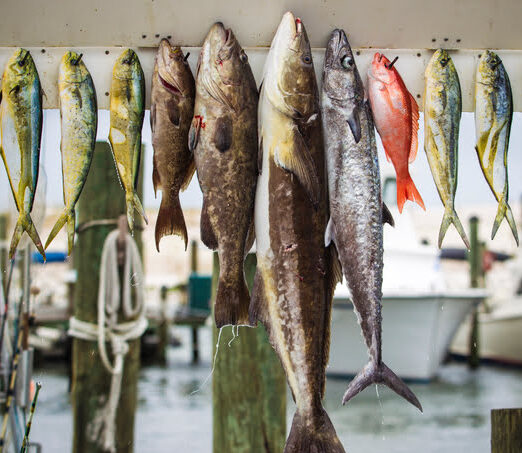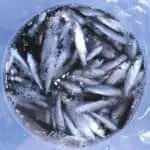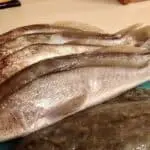What if I told you that you’ve been tossing out the most delicious and tasty part of mullet…
Yes, I’m talking about mullet roe!
In most westernized countries, mullet roe is tossed out along with the bones and skin after cleaning. In fact, many people don’t even eat mullet (no, I’m not talking to you Lousianna, or Florida).
But, in other parts of the world mullet roe is considered a delicacy, and it may be worth your time to give it a try.
In this article, I’ll tell you everything you need to know about mullet roe…where it comes from, how to prepare it and much more.
What Is Mullet Roe?
Mullet roe is, in terms of food, is an egg sac that is cut out of the bottom of a mullet (a type of fish) that is most commonly turned into a delicacy called Bottarga by curing it and drying it out.
Mullet roe is shaped like a tongue and must be cut out of the fish properly because it is, in simplest terms, a sac filled with fish eggs. Extracting it from the fish is tricky and requires a delicate, skillful hand to do properly.
Where does Mullet Roe come from?
Mullet roe is the egg-filled sac that comes from any number of mullet species, a coastal schooling fish found all over the world.
Is Mullet Roe The Same As Caviar?
Caviar is a much more popular delicacy when compared to Bottarga, but when people find out it is made from mullet roe, they may think it’s the same thing.
The difference is from which fish the roe comes from and Bottarga sacs are always cooked and prepared intact, while caviar is cut out of the sac: that is why it looks like little eggs.
Caviar comes from the roe of a sturgeon fish and mullet roe from a mullet. There are other varieties of caviar that come from salmon or trout, but these are referred to as ‘Poor man’s Caviar.’
What Can You Do With Mullet Roe?
One common thing that is done with mullet roe is salting and curing it, then drying it out.
It is a long process that can take anywhere from days to weeks if done in the sun – which is traditionally how it’s done in Asian cultures. It can also be dried out in a dehydrator.
Once you’ve prepared the roe this way, there are lots of ways you can enjoy this salty treat. It can be ground up on top of plates of pasta, which is done in Mediterranean cultures.
This type of bottarga is typically the driest type of mullet roe available on the market, and it is also the most expensive because of how long the process takes.

The Japanese like to make it into sushi, or served it with vegetables, and is often paired with sake. The Japanese call is Karasumi. It has many names in many cultures, all of which pair it with their unique foods.
Roe isn’t commonly eaten in western cultures, but it is sometimes called Florida gold because Florida is the biggest consumer of it and that is where mullets are fished for the most.
On the east coast, people deep-fry, barbeque, or smoke it. Drying it out, in America, into a bottarga isn’t as common as it is on the other side of the globe.
How Do You Prepare Mullet Roe?
There are a lot of ways to prepare mullet roe, from smoking and curing, to deep-frying or raw.
Growing up in Florida, I am most familiar with fried mullet roe. Simply extract the roe-sac from the mullet and carefully batter with your favorite flour and seasoning.
Gently fry the mullet roe until crispy on the outside and gooey on the inside. It’s delicious when served over eggs, and pairs nicely with grits and grunts (Another Florida delicacy).
Taking the roe from mullet:
First, you have to cut the roe out of the mullet carefully, making sure to not cut into the sac and have the eggs spill out.
Cut off the bottom fin of the fish, then carefully cut along the underbelly of the mullet, being cautious not to cut too deep and pierce the roe. Reach into the fish’s innards and gently pull them out.
Separate the intestines from the roe – taking extra care not to yank the roe out of the fish.
To avoid doing this, cut some of the meat off the fish near the tip of the roe before yanking it out.
Once you have the roe out, cut the excess belly meat off the tip of the roe gently to avoid having any of the eggs come out.
Drying out Mullet Roe for a Bottarga:
Now that you have the roe out of the fish, you need to carefully separate the two sacs from each other. Be delicate and careful not to tear the two sacs apart.
Once this is done, lie down the sac and tie off the end so none of the eggs get squeezed out in the next part.
The key thing to remember during this entire process is to do everything carefully, especially if you are new to this. Over time, you will learn to do this faster, but for beginners, do it slow and steady until you have the hang of it.
Now that the roe is tied off, carefully run your finger down the bloodline to squeeze out the blood.
The roe is then pressed gently, heavily salted, and cured.
It is cured for different amounts of times in different cultures: everyone who prepares it has their preference. A safe bet is to let it cure for about an hour, to an hour and a half.
After it’s cured, you need to wash off the salt and dry it out.
The drying out process can be done in a dehydrator or it can be done in the sun and can take anywhere from a couple of days to over a week.
Since this is a delicacy, everyone treats it differently.
In Mediterranean culture, they typically dry their roe out more than they do in Asian cultures. This is because it is used mostly to be ground up onto pasta or other entries, so it needs to be as hard as possible.

Do You Love Seafood?
In your drying out process, you can choose to do it any way you want to, depending on how you plan on eating it.
The good thing about drying out the mullet roe is that it can be frozen for however long you want. It might be a smart idea to dry out several roes at the same time, since the process is so long, and storing them for later is so simple.
If you don’t plan on drying out the roe, then you won’t have a bottarga.
But you can still prepare it in different ways (try it smoked!).
No matter how you choose to treat a mullet roe, it needs to be handled with care so that the sac doesn’t tear, which will lead to eggs spilling out and ruining the integrity of the roe.
How To Serve Mullet Roe
Mullet roe can be served and used in a variety of ways. When it is dried out, it is grated on top of pasta and other dishes at high-end restaurants.
It can be grated over many foods: rice, mashed potatoes, steamed vegetables.
Some people even grate it into their eggs, particularly over hard-boiled eggs, dipping it into the yolk for added flavor.
Like any food, chefs are always experimenting with it in a variety of ways to find new culinary creations. In some restaurants in Asia, chefs even go as far as searing it with a blowtorch after pouring whiskey over top of it!
One thing to note is once you have a dried-out piece of mullet roe, it isn’t recommended to cook it. A lot of work was done to prepare it, so gently warming is typically how people serve it or they eat it as it is. It can be baked at a low temperature or carefully seared.
Can You Smoke Mullet Roe?
You can smoke a fresh mullet roe, some people in America choose to do this. In my opinion, it will be nowhere near as flavorful as a bottarga, but it can still be tasty if it is at least cured overnight in a salt brine before smoking it.
What Are The Different Types Of Mullet Roe?
There is only one type of mullet roe, because it is a part of the specific fish, mullet! But there are many different ways to prepare mullet roe as we have discussed.
There are levels to how you can dry it, and you will see the driest types of mullet roe selling as bottarga at the highest price.

Bottarga is a mullet roe; its name is only different because of how it’s dried out. There are, however, different bottarga, but most are still made from mullet roe.
There are roe’s from other fish that also sold as bottarga, trying to imitate a real mullet roe, and they aren’t as expensive.
The way Caviar is supposed to be taken from the roe of a sturgeon (and no other fish) an authentic bottarga can only come from a mullet.
For example, If you see bottarga di tonne for sale, for example, you should know that it isn’t true bottarga because it is made from a roe sac taken from a tuna fish.
How Much Is Mullet Roe Worth?
Depending on how you purchase Mullet Roe – if you purchase a dried-out bottarga, or if you buy an actual mullet fish, or fresh cut-out roe – the price will drastically be different because of how much work went into making the bottarga.
A fully dried-out bottarga can sell for over 100 dollars a pound. Actual mullet roe is much cheaper to buy. A mullet fish itself can be as sold for as little as 3 dollars a pound.
When Is Mullet Roe In Season?
Mullet carry roe during the Fall spawning season. This is called the ‘mullet run’ when mullet migrate up and down coastlines in large numbers spawning.

Growing up in Florida, I’ve been surrounded by saltwater my entire life…and I love sharing my passion with others.
To learn more about why I started Saltwater Mecca, visit the ABOUT page.
Thank you for reading this article. Browse around & have some fun!





